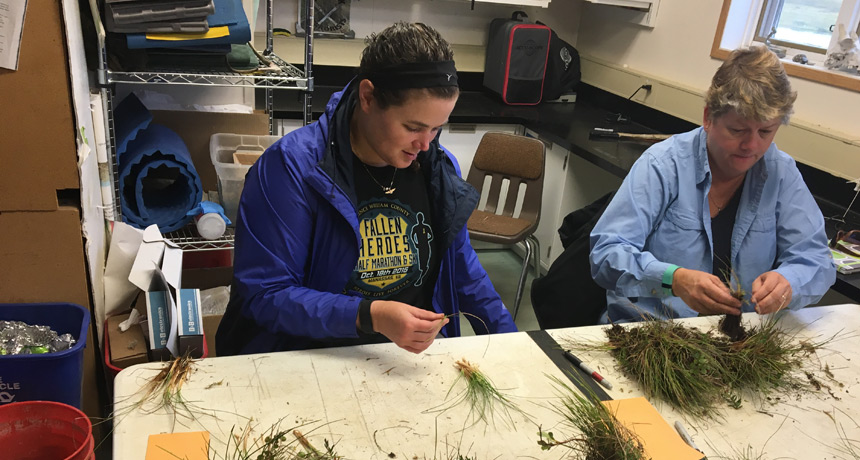Teachers get to do cool science in the Arctic
A research experience for teachers provides experience in the latest scientific studies

Jolene McDowell (left) and Mary Richmond (right) pry apart grass tussocks for science at the Toolik research station in Alaska.
B. Brookshire/SSP
TOOLIK FIELD STATION, Alaska — Two teachers are sitting in a laboratory. Their dirty hands are buried in tussocks of grass. Each is having the time of her life.
Mary Richmond is a sixth grade science teacher at Cache LaPoudre Middle School in Laporte, Colo. Jolene McDowell teaches high school biology at Great Mills High School in Maryland. Each had scooped up the tussocks a day earlier, in a tundra research plot. These women have spent the past week engaged in science as part of the Research Experience for Teachers Program. Their site: the Toolik Field Station, only 188 kilometers (117 miles) south of the Arctic Ocean. Armed with research experience, these teachers are excited to head back to their classrooms in a few weeks. There each will share stories with her students about science in the Arctic.
“We have a lot of teachers go through teacher-preparation programs and don’t actually do science in those programs,” says Amanda Morrison. Afterwards, she says, “you find them teaching it in a very cookbook way.” Morrison coordinates K-12 education at the Natural Resource Ecology Laboratory at Colorado State University, in Fort Collins. Every summer, she also organizes research experiences for teachers here at Toolik. She hopes that bringing teachers to the research station to interact with scientists — and trying their hands at research — will give each a deeper understanding of how science works outside of a textbook.
For their two-week experience, Richmond and McDowell are living in a permanent tent (called a weatherport). So far, they have helped to set up a temporary laboratory, processed soil samples and mounted other samples onto microscope slides. The teachers also took trucks to field sites where scientists have manipulated the tundra to examine how climate change and melting permafrost might affect ecosystems.
And, of course, they spent time prying apart grass tussocks. Now they are separating out single grass plants, carefully placing each in an envelope to be measured.
“As teachers in the classroom, I think it’s important that we get out and do science,” Richmond says. This experience has rekindled her enthusiasm for science, she says. Richmond is looking forward to taking it back to the classroom. “If I’m excited about it the kids are more likely to be excited about it,” she notes. And in her sixth grade classroom, enthusiasm is critical. “If they’re bored with science in middle school and high school they’re not going to keep taking it,” she notes.
It’s also important to show students that teachers are lifelong learners, explains McDowell. “You never pass up an opportunity to learn or to show your students that you want to learn and you’re willing to put yourself out there and be uncomfortable,” she says. “I’ve never been this far north before. This is a location where you don’t even flush your toilet paper. But I’m willing to be here to learn and experience something new.”
The Toolik research station brings in a different number of teachers each year. Some years there may be just one; other times there could be up to eight. Openings are generally posted in March and can be found on the Natural Resource Ecology Laboratory website.
After their stay, the two teachers, along with others at research sites around the United States, will have a year to translate their experience to something for the classroom. They can add to their curriculum, make a presentation or come up with a class activity.
McDowell and Richmond are already brimming with ideas.
Richmond is looking forward to getting her kids outside to look at local organisms. McDowell is writing about her Arctic experiences on a blog and planning to analyze soil samples with her high school students, using methods she learned at Toolik.
It’s important to try research, McDowell says, because “science is continually changing.” Scientists now use very different methods than they did 20 years ago, she notes. Today they take notes on iPads and share documents across the internet. Learning how scientists have updated their methods means that she can send her students to college prepared for what science is like in the 21st century.
Follow Eureka! Lab on Twitter